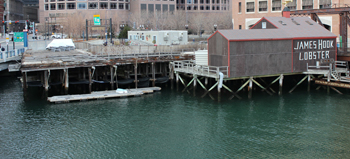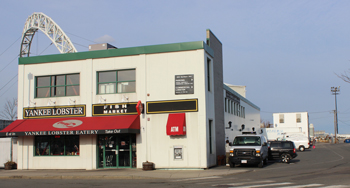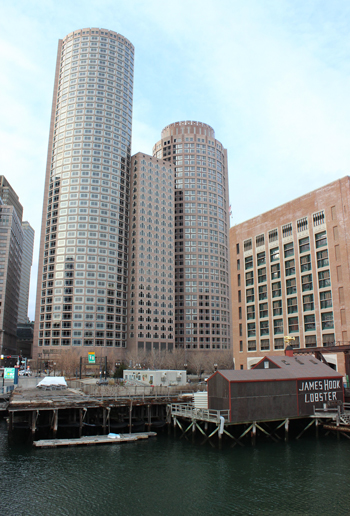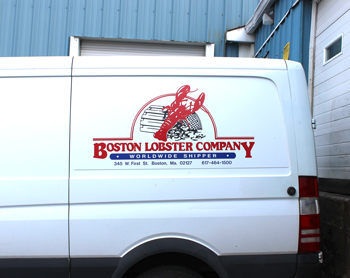Lobster From Away
by Fishermen’s Voice staff

James Hook building at right which survived the 2009 fire that burned a larger building atop the wharf at left. The small gray building in the background, built after the fire, is the Hook retail store. Fishermen’s Voice photo
A lot of Maine lobster is shipped to and through Canadian, Boston and New York markets.
Canada processes more than the U.S., but also ships a lot of live lobster as do the dealers in Boston.
Lobstermen often wonder who are the dealers in Boston that handle Maine lobster. We visited a few, randomly selected, to talk about their businesses and get their thoughts on the lobster business from where they operate on the front lines of the international lobster market.
All three are located on the Boston waterfront, almost within sight of each other, with one holding down the same wharf it has been on since 1925. That wharf belongs to the James Hook Lobster company on the corner of Atlantic Avenue and Seaport Boulevard (formerly Northern Avenue). Seaport Boulevard crosses the Fort Point Channel and runs through South Boston’s new marine industrial waterfront zone. The Boston Seafood Show is in that part of town along with the Boston Fish Pier and dozens of business that have relocated there in the last 15 years. When James Hook started business in a large wooden building built on a wharf, it was surrounded by 3- and 4-story brick commercial buildings. They were the evidence of America’s manufacturing power that had developed in the 19th century. Across the Fort Point Channel, block after block of massive brick industrial buildings stretched to the wooden three-decker neighborhoods of South Boston.
Late on a Thursday night in 2009, a fire started in the James Hook Lobster building. It roared through the building until the wee hours of Friday morning. Eddie Hook with his three brothers and two sisters run the family business. While the embers were still smoldering in the building where three generations of his family had worked, Eddie said he was offered space over the bridge in the seaport area. Saturday morning he went over to get set up to buy lobsters to supply his customers. Knowing, he said, that if he didn’t, someone else would. On Monday afternoon they were packing and shipping lobster from the new location. In addition to adjusting to the new place, he had to adjust to going from moving a 250,000 pounds of lobster to 50,000 pounds after the fire.
The lobster business is a shifting landscape that requires a willingness to change. “It’s always changing and you have to adapt or you don’t survive,” said Hook. Hook got into the emerging export lobster markets about fifteen years ago. He shipped to Italy, Spain, France and other European countries. When China opened up he shipped to Asia, but there was more risk. A lot of others jumped into the Asia market and it began to make less sense for him than working with his established domestic markets.

Yankee Lobster retail store and restaurant. In the background is Commercial Lobster’s buying and distribution facility. Manger Frank Zanti said some of his customers were now his competition. To the right is the waterfront and Boston Fish Pier beyond. Fishermen’s Voice photo
There is a wooden building on the Hook wharf that survived the fire. A new building was built on the site near that building. It is a retail outlet for raw and prepared seafoods that markets to the new population of workers and residents of the skyscrapers that now line the Boston waterfront. Eddie said their lobster roll was voted best in Boston last year.
Over the Seaport Boulevard bridge, about a quarter mile from James Hook Lobster, is Yankee Lobster. It too has a retail outlet and restaurant they opened in 2000 to serve the people working the business district. Summers bring visitors and tourists to the outdoor music venue next door. Commercial Lobster is a wholesale seafood company started by the Zanti family in 1950. In 2000 Commercial Lobster opened Yankee Lobster on the same lot where they continue to supply lobster and other seafood to their regional markets. When they started in 1950 they were located further up Atlantic Avenue in the North End of Boston. About 15% of their business is in mid-Atlantic and western markets. Frank Zanti, the assistant general manager, said of the changing business that more people are marketing lobster today. People who at one time were there customers are now their competition. Zanti said they are not exporting now but will likely have export markets in their future. For now they are focusing on developing their expanding regional wholesale and retail operations.

The new Boston waterfront towers over the few remaining older waterfront businesses.When Hook started in 1925, 3 and 4 story buildings were the skyscrapers. Fishermen’s Voice photo
Commercial buys lobster from Maine and Canada. Their tank room holds on average 15,000 pounds in a building with 5,000 square feet on each of two floors.
Yankee is next to the Boston Fish Pier on the Main Channel of Boston Harbor. About half a mile across the Seaport Zone on a street that borders it is Boston Lobster. Boston Lobster’s building and location in many ways is the face of the modern international lobster dealer. Too far from the water to have boats unload at the wharf and in a large non-descript metal building at the edge of an industrial zone, it might be in any number of businesses. But once the door is opened it looks like most lobster dealing operations—wet concrete floors, the sound of fork lifts, clear thermal plastic sheets hung over openings to other sections, etc. The office however again offers no clues as to what kind of business is being conducted. There are desks and bulletin boards along the walls and computer screens aplenty.
Boston Lobster exports a lot of lobster. Bob Behrman is one of two principals. He said the company was started in 1986. His partner Anthony Neil Zarella was a fisherman before starting the lobster buying and marketing business. Behrman owned a fish market before moving to the lobster industry. The company has national domestic markets. About 30% of its business is export. Boston exports live lobster to seven European capitals, six countries in Asia including Japan, Vietnam and Cambodia and seven capitals in China including Beijing, Shanghai, Guangzhou, Hong Kong and Taiwan.

Boston Lobster’s low-profile Seaport Zone building in the background. The signs on their trucks, on the building—not so much. Fishermen’s Voice photo
Boston got into the Japanese market 20 years ago before the Japanese economy tanked. The European markets became strong, but now they want cheaper product. “Asian markets are keeping the prices up,” said Behrman. He also noted the shifting nature of the lobster business. “Asians are spending money, but this year is different. Now they want soft shell vs the previous demand for hard shell. They do want an A grade soft shell. They want it even with the higher, twice, mortality rate in shipped soft shells.” That’s a rate that is high even in the special protective boxes they’re shipped in. “China wants live, Korea wants hardshell. It is almost two days by air to Vietnam where they are willing to accept 15% mortality.”
Behrman said Korea and China have taken off. “Three to five years ago I was getting three to four calls a day from China,” he said. “There are more exporters and more dealers today. China has a more affluent population now and they are developing a taste for lobster. This is less true of the European Union. There are better margins in China, but there is more risk. It is also very tough to collect losses in Asia.” Boston lobster requires export customers prepay or have business insurance.
“We ship to wholesalers in Asia. One internet company there sells lobster online. Boston Lobster ships them lobster in 30-pound boxes. Their trucks meet our plane when it lands and deliver directly to their customers. No warehouse, no holding tanks and a small office,” said Behrman. No warehouse, no holding tanks and a small office,” said Behrman. With more direct flights to Asia it is now 30 hours away rather than 48 hours. There has been more hardshell and it’s available for a longer period, said Behrman. Despite the recent economic news about the Chinese economy, Behrman thinks China and the rest of Asia will continue to be a growing market for lobster.
